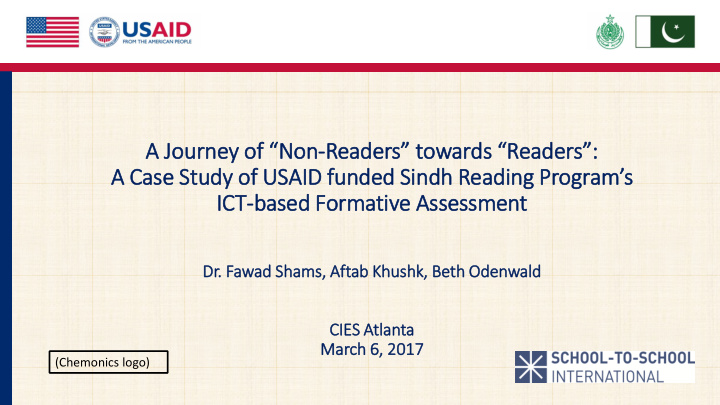



A Journey of “Non - Readers” towards “Readers”: A Case Study of USAID funded Sindh Reading Program’s IC ICT-based Formativ ive Assessment Dr Dr. Fawad Sh Shams, Aftab Khushk, Beth th Odenwald CIE IES Atl tlanta Mar arch 6, 6, 20 2017 17 (Chemonics logo)
• Five Year Program (January 2014-January 2019) • Sindh Province: 8 districts • Beneficiaries: – 400,000 Learners of Grades 1 & 2 – Up to 15,000 teachers – 30,000 Non-Formal Education (NFE) learners – 10 Public and 106 Schools Libraries – 500 education officials for continuous teacher professional development and administering EGRA
What is formative assessment? FA is a continuous process FA 1 ‘Identifying learners’ strengths and weaknesses during instruction (daily, weekly, monthly) to make changes in Inform instruction teaching/learning in real time’ FA 2
Types of formative assessment Informal Formal Observations Quizzes Internal Questioning Rating forms Sindh Reading Program Ongoing learning Spot checks External assessments
Why ICT-Based FA? • SRP has traditional design of evaluation • Teachers needed consistent classroom-based assistance • We wanted a real time data to help teachers/students • ICT-based FA was the only solution • SRP needed strategically disseminate results to the Government of Sindh (GoS)
How are we doing it? • Using tablets (why use ICT?) • Administered by field teams/mentors (add video clip) • EGRA-like assessments • Sample of G1 and G2 students (10/20 respectively, covering 70,000) • G2: Zero score and non-zero score (define these terms) • All intervention schools ( type of intervention OTJ support and TLMs) • Every 4-6 weeks
Who was assessed and when? Detail FA 1 FA 2 FA 3 Level Phase Phase 1 Phase 2 Schedule Oct 2015 Feb 2016 Apr 2016 Sample 10 students 10 students Grade 1 n/a in each in each school school Schedule Oct 2015 Feb 2016 Apr 2016 Sample All students 20 students 20 students Grade 2 in each in each in each school school school
What we assessed?- Grade-2 Grade-1 Grade-2-Non readers Grade-2 Readers - Orientation to print - Letter name recognition - Phoneme isolation All same tasks in addition - Receptive vocabulary - Letter-name recognition to “Letter Name (object only) - Nonword reading recognition” - Oral Reading Fluency (ORF) - Individual word reading - Comprehension of ORF - Comprehension of words text read
WHAT HAVE WE LEARNED? BENEFITS • Timeliness • Quality Assurance • Increased reliability of tests and test administration • Instant feedback to teachers • Motivations of teachers increased based on the FA results
WHAT HAVE WE LEARNED? CHALLENGES • Development of quality tools every month • Hardware and software issues during uploading of tools and data collection • Developing teacher-friendly offline reports • Limited internet connectivity in district offices • Electricity failures in remote districts • Lack of familiarity with ICT among test administrators
Did it help? • Many students who could not read (Sindhi/Urdu languages) a single word in October 2015 were able to by April 2016. Average CWPM of 16.7 . 100 100 100 100 100 100 100 100 89.4 78.9 72.9 69.5 69.3 68.4 55 49.2 DADU JACCOBABAD KAMBAR KARACHI KASHMORE KHAIRPUR LARKANA SUKKUR 15-Oct 16-Apr
Recommend
More recommend